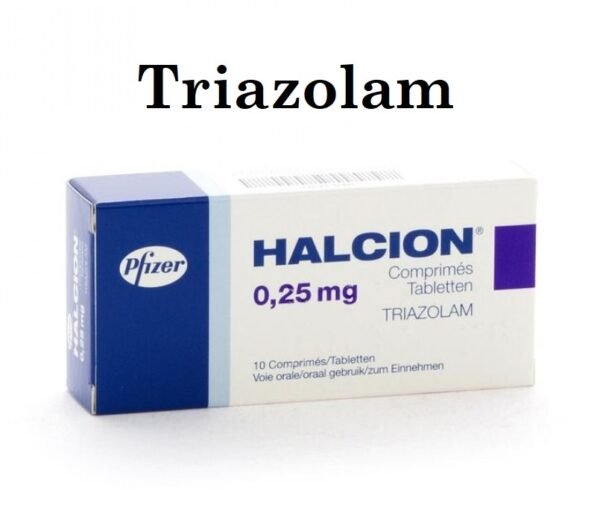Triazolam (Halcion) is a benzodiazepine drug that is primarily used in the short-term treatment of patients who have difficulty falling asleep. It has a duration of action of about 6 to 7 hours similar to lorazepam (ativan) and should be taken at night.
Triazolam Uses:
-
Insomnia:
- Used for short-term (generally 7 to 10 days) treatment of insomnia
-
Off Label Use of Triazolam in Adults:
- Used for oral sedation before outpatient dental procedures
Triazolam Dose in Adults
Triazolam Dose in the short-term treatment of Insomnia:
- Usual dose: 0.25 mg HS; 0.125 mg HS may be sufficient in some patients, like those with low BMI; max dose is 0.5 mg per 24 hours
Triazolam Dose in the treatment of Dental pre-procedure oral sedation (off-label):
- 25 mg given 60mins prior to procedure; use 0.125 mg in elderly patients or patients sensitive to sedative effects
Triazolam Dose in Children
Triazolam Dose in the short-term treatment of Insomnia:
-
Adolescents ≥18 years:
- Oral: 0.125 to 0.25 mg HS; in some patients, adequate effects may be achieved by 0.125 mg HS like those with low BMI; maximum daily dose: 0.5 mg per 24 hours.
Pregnancy Risk Factor X
- A case report shows that Triazolam can cross into the placenta in cases of maternal overdose.
- Some benzodiazepines can have sedative effects.
- Premature births and low birth weight may be more common if the mother uses benzodiazepines; late-term exposure may lead to hypoglycemia in the neonate and other respiratory problems.
- Neonatal withdrawal symptoms may occur within days or weeks of birth due to the use of benzodiazepine. Also, "floppy infant syndrome" may also be a possibility.
- Triazolam should not be used in pregnancy.
Use while breastfeeding
- Although data for triazolam are not available, it is expected that all benzodiazepines will be secreted into breast milk.
- Some benzodiazepines can cause sleepiness, lethargy, and weight loss in nursing infants if they are taken by their mothers.
- The manufacturer doesn't recommend breastfeeding during therapy.
Dose in Kidney Disease:
No dosage adjustments have been provided in the manufacturer’s labeling; use cautiously.
Dose in Liver disease:
No dosage adjustments have been provided in the manufacturer’s labeling; use cautiously.
Common Side Effects of Triazolam:
-
Central nervous system:
- Drowsiness
Less Common Side Effects of Triazolam:
-
Central Nervous System:
- Headache
- Dizziness
- Ataxia
- Nervousness
-
Gastrointestinal:
- Nausea
- Vomiting
Contraindications to Triazolam:
- Hypersensitivity to triazolam, other prescription benzodiazepines or any component of the formulation
- Concurrent use of cytochrome P450 3A inhibitors (CYP 3A), including itraconazole and ketoconazole, nefazodone and many HIV protease inhibitors
- Pregnancy
Warnings and precautions
- Anterograde amnesia
- It is possible to experience anterograde amnesia.
- Depression in the CNS:
- CNS depression can cause impairment of mental or physical abilities. Patients should be cautious about driving or operating machinery that requires mental alertness.
- Hypersensitivity reactions
- Triazolam can cause anaphylaxis or angioedema. Triazolam should not be re-used in patients with angioedema.
- Paradoxical reactions
- Use of benzodiazepines may lead to paradoxical reactions such as hyperactive or aggressive behavior.
- Patients at higher risk include:
- Adolescent/pediatric patients
- Geriatric patients
- Patients with a history or alcohol abuse disorder
- Psychiatric/personality disorders
- Activities that are sleep-related:
- The use of benzodiazepines can cause dangerous sleep-related activities, such as driving, cooking, eating, and calling while you're asleep.
- Depression
- Patients with depression or suicidal risk should be used cautiously. It is possible to reduce the risk by prescribing as little medication as possible for suicidal patients.
- Use of drugs:
- Avoid using if you have a history or are suffering from acute alcoholism.
- This could lead to drug dependence. Tolerance, psychological and/or physical dependence may result from prolonged use.
- Hepatic impairment
- Avoid use in patients with hepatic impairment because the drug has a high hepatic metabolism.
- Renal impairment
- Be careful.
- Respiratory disease
- Avoid use in cases of COPD, respiratory compromise, and sleep apnea.
Triazolam: Drug Interaction
|
Alcohol (Ethyl) |
Alcohol's CNS depressing effect may be amplified by CNS depressants (Ethyl). |
|
Alizapride |
CNS depressants may have an enhanced CNS depressant impact. |
|
Aprepitant |
May elevate CYP3A4 substrates' serum concentration (High risk with Inhibitors) |
|
Bosentan |
May lower the serum level of CYP3A4 substrates (High risk with Inducers). |
|
Brexanolone |
CNS Depressants may enhance the CNS depressant effect of Brexanolone. |
|
Brimonidine (Topical) |
May enhance the CNS depressant effect of CNS Depressants. |
|
Bromopride |
May enhance the CNS depressant effect of CNS Depressants. |
|
Cannabidiol |
May enhance the CNS depressant effect of CNS Depressants. |
|
Cannabis |
May enhance the CNS depressant effect of CNS Depressants. |
|
Chlorphenesin Carbamate |
May enhance the adverse/toxic effect of CNS Depressants. |
|
Clofazimine |
May increase the serum concentration of CYP3A4 Substrates (High risk with Inhibitors). |
|
CNS Depressants |
May enhance the adverse/toxic effect of other CNS Depressants. |
|
CYP3A4 Inducers (Moderate) |
May decrease the serum concentration of CYP3A4 Substrates (High risk with Inducers). |
|
CYP3A4 Inhibitors (Moderate) |
May decrease the metabolism of CYP3A4 Substrates (High risk with Inhibitors). |
|
Deferasirox |
May decrease the serum concentration of CYP3A4 Substrates (High risk with Inducers). |
|
Dexamethasone (Systemic) |
May decrease the serum concentration of Triazolam. |
|
Dimethindene (Topical) |
May enhance the CNS depressant effect of CNS Depressants. |
|
Doxylamine |
May enhance the CNS depressant effect of CNS Depressants. Management: The manufacturer of Diclegis (doxylamine/pyridoxine), intended for use in pregnancy, specifically states that use with other CNS depressants is not recommended. |
|
Dronabinol |
May enhance the CNS depressant effect of CNS Depressants. |
|
Duvelisib |
May increase the serum concentration of CYP3A4 Substrates (High risk with Inhibitors). |
|
Erdafitinib |
May decrease the serum concentration of CYP3A4 Substrates (High risk with Inducers). |
|
Erdafitinib |
May increase the serum concentration of CYP3A4 Substrates (High risk with Inhibitors). |
|
Esketamine |
May enhance the CNS depressant effect of CNS Depressants. |
|
Fosaprepitant |
May increase the serum concentration of CYP3A4 Substrates (High risk with Inhibitors). |
|
Fosnetupitant |
May increase the serum concentration of CYP3A4 Substrates (High risk with Inhibitors). |
|
HydrOXYzine |
May enhance the CNS depressant effect of CNS Depressants. |
|
Ivosidenib |
May decrease the serum concentration of CYP3A4 Substrates (High risk with Inducers). |
|
Kava Kava |
CNS depressants' harmful or toxic effects could be increased. |
|
Larotrectinib |
May elevate CYP3A4 substrates' serum concentration (High risk with Inhibitors). |
|
Lofexidine |
CNS depressants may have an enhanced CNS depressant impact. Management: Separate drug interaction monographs go into further detail about the medications indicated as exceptions to this book. |
|
Magnesium Sulfate |
CNS depressants may have an enhanced CNS depressant impact. |
|
Melatonin |
Could make benzodiazepines more sedative. |
|
MetyroSINE |
CNS Depressants may enhance the sedative effect of MetyroSINE. |
|
Minocycline |
May enhance the CNS depressant effect of CNS Depressants. |
|
Mirtazapine |
CNS Depressants may enhance the CNS depressant effect of Mirtazapine. |
|
Nabilone |
May enhance the CNS depressant effect of CNS Depressants. |
|
Netupitant |
May increase the serum concentration of CYP3A4 Substrates (High risk with Inhibitors). |
|
Palbociclib |
May increase the serum concentration of CYP3A4 Substrates (High risk with Inhibitors). |
|
Piribedil |
Piribedil's CNS depressing effects may be enhanced by other CNS depressants. |
|
Pramipexole |
The sedative effects of pramipexole might be enhanced by CNS depressants. |
|
ROPINIRole |
The sedative effects of CNS depressants may increase those of ROPINIRole. |
|
Rotigotine |
Rotigotine's sedative effects may be boosted by CNS depressants. |
|
Rufinamide |
CNS depressants' harmful or toxic effects could be increased. Particularly, drowsiness and lightheadedness could be worsened. |
|
Sarilumab |
May lower the serum level of CYP3A4 substrates (High risk with Inducers). |
|
Selective Serotonin Reuptake Inhibitors |
Selective serotonin reuptake inhibitors may have a worsened or more hazardous effect when taken with CNS depressants. Particularly, there may be an increased risk of psychomotor impairment. |
|
Siltuximab |
May lower the serum level of CYP3A4 substrates (High risk with Inducers). |
|
Simeprevir |
Triazolam serum levels can rise. |
|
Teduglutide |
Benzodiazepines' serum concentration may rise. |
|
Tetrahydrocannabinol |
CNS depressants may have an enhanced CNS depressant impact. |
|
Tetrahydrocannabinol and Cannabidiol |
CNS depressants may have an enhanced CNS depressant impact. |
|
Tocilizumab |
May lower the serum level of CYP3A4 substrates (High risk with Inducers). |
|
Trimeprazine |
CNS depressants may have an enhanced CNS depressant impact. |
|
Yohimbine |
May lessen the therapeutic impact of anxiety medications. |
|
Risk Factor D (Consider therapy modification) |
|
|
Blonanserin |
CNS Depressants may enhance the CNS depressant effect of Blonanserin. |
|
Buprenorphine |
|
|
Chlormethiazole |
May enhance the CNS depressant effect of CNS Depressants. Management: Monitor closely for evidence of excessive CNS depression. The chlormethiazole labeling states that an appropriately reduced dose should be used if such a combination must be used. |
|
CloZAPine |
Benzodiazepines may intensify CloZAPine's harmful or hazardous effects. Prior to starting clozapine, consider lowering the dose of benzodiazepines or even stopping them altogether. |
|
CYP3A4 Inducers (Strong) |
May increase the metabolism of CYP3A4 Substrates (High risk with Inducers). Management: Consider an alternative for one of the interacting drugs. Some combinations may be specifically contraindicated. Consult appropriate manufacturer labeling. |
|
Dabrafenib |
May decrease the serum concentration of CYP3A4 Substrates (High risk with Inducers). Management: Seek alternatives to the CYP3A4 substrate when possible. If concomitant therapy cannot be avoided, monitor clinical effects of the substrate closely (particularly therapeutic effects). |
|
Droperidol |
CNS depressants may have an enhanced CNS depressant impact. Consider lowering the dosage of droperidol or other CNS drugs (such as opioids or barbiturates) when they are used concurrently. In separate drug interaction monographs, exceptions to this monograph are covered in more detail. |
|
Enzalutamide |
May lower the serum level of CYP3A4 substrates (High risk with Inducers). Treatment: Enzalutamide should not be used concurrently with CYP3A4 substrates that have a limited therapeutic index. Enzalutamide use, like with the use of any other CYP3A4 substrate, should be done cautiously and under close observation. |
|
Erythromycin (Systemic) |
Triazolam serum levels can rise. Management: Look into alternatives to using erythromycin and triazolam together. If coupled, exercise greater caution and keep a closer eye out for adverse effects of triazolam. Triazolam dosage reductions can be required. |
|
Flunitrazepam |
CNS Depressants may enhance the CNS depressant effect of Flunitrazepam. |
|
HYDROcodone |
CNS Depressants may enhance the CNS depressant effect of HYDROcodone. Management: Avoid concomitant use of hydrocodone and benzodiazepines or other CNS depressants when possible. These agents should only be combined if alternative treatment options are inadequate. If combined, limit the dosages and duration of each drug. |
|
Lorlatinib |
May decrease the serum concentration of CYP3A4 Substrates (High risk with Inducers). Management: Avoid concurrent use of lorlatinib with any CYP3A4 substrates for which a minimal decrease in serum concentrations of the CYP3A4 substrate could lead to therapeutic failure and serious clinical consequences. |
|
Methadone |
The CNS depressive effect of methadone may be strengthened by benzodiazepines. Management: When at all possible, clinicians should refrain from combining the use of benzodiazepines with methadone; nonetheless, any combination should be used with extreme caution. |
|
Methotrimeprazine |
The CNS depressing action of methotrimeprazine may be enhanced by CNS depressants. The CNS depressant action of CNS Depressants may be strengthened by methotrimeprazine. Management: Start concurrent methotrimeprazine therapy while reducing the adult dose of CNS depressants by 50%. Only once a clinically effective dose of methotrimeprazine has been established should additional CNS depressant dosage modifications be made. |
|
Mitotane |
May decrease the serum concentration of CYP3A4 Substrates (High risk with Inducers). Management: Doses of CYP3A4 substrates may need to be adjusted substantially when used in patients being treated with mitotane. |
|
Opioid Agonists |
CNS Depressants may enhance the CNS depressant effect of Opioid Agonists. Management: Avoid concomitant use of opioid agonists and benzodiazepines or other CNS depressants when possible. These agents should only be combined if alternative treatment options are inadequate. If combined, limit the dosages and duration of each drug. |
|
OxyCODONE |
CNS Depressants may enhance the CNS depressant effect of OxyCODONE. Management: Avoid concomitant use of oxycodone and benzodiazepines or other CNS depressants when possible. These agents should only be combined if alternative treatment options are inadequate. If combined, limit the dosages and duration of each drug. |
|
Perampanel |
May enhance the CNS depressant effect of CNS Depressants. Management: Patients taking perampanel with any other drug that has CNS depressant activities should avoid complex and high-risk activities, particularly those such as driving that require alertness and coordination, until they have experience using the combination. |
|
St John's Wort |
May decrease the serum concentration of CYP3A4 Substrates (High risk with Inducers). Management: Consider an alternative for one of the interacting drugs. Some combinations may be specifically contraindicated. Consult appropriate manufacturer labeling. |
|
Stiripentol |
May increase the serum concentration of CYP3A4 Substrates (High risk with Inhibitors). Management: Use of stiripentol with CYP3A4 substrates that are considered to have a narrow therapeutic index should be avoided due to the increased risk for adverse effects and toxicity. Any CYP3A4 substrate used with stiripentol requires closer monitoring. |
|
Suvorexant |
CNS Depressants may enhance the CNS depressant effect of Suvorexant. Management: Dose reduction of suvorexant and/or any other CNS depressant may be necessary. Use of suvorexant with alcohol is not recommended, and the use of suvorexant with any other drug to treat insomnia is not recommended. |
|
Tapentadol |
May enhance the CNS depressant effect of CNS Depressants. Management: Avoid concomitant use of tapentadol and benzodiazepines or other CNS depressants when possible. These agents should only be combined if alternative treatment options are inadequate. If combined, limit the dosages and duration of each drug. |
|
Theophylline Derivatives |
May diminish the therapeutic effect of Benzodiazepines. |
|
Zolpidem |
CNS Depressants may enhance the CNS depressant effect of Zolpidem. Management: Reduce the Intermezzo brand sublingual zolpidem adult dose to 1.75 mg for men who are also receiving other CNS depressants. No such dose change is recommended for women. Avoid use with other CNS depressants at bedtime; avoid use with alcohol. |
|
Risk Factor X (Avoid combination) |
|
|
Azelastine (Nasal) |
CNS Depressants may enhance the CNS depressant effect of Azelastine (Nasal). |
|
Bromperidol |
May enhance the CNS depressant effect of CNS Depressants. |
|
Conivaptan |
May elevate CYP3A4 substrates' serum concentration (High risk with Inhibitors). |
|
CYP3A4 Inhibitors (Strong) |
Triazolam serum levels can rise. |
|
Fusidic Acid (Systemic) |
May increase the serum concentration of CYP3A4 Substrates (High risk with Inhibitors). |
|
Idelalisib |
May increase the serum concentration of CYP3A4 Substrates (High risk with Inhibitors). |
|
OLANZapine |
May intensify the harmful or negative effects of benzodiazepines. Due to the possibility of cumulative negative side effects, avoid using parenteral benzodiazepines and intramuscular olanzapine concurrently (e.g., cardiorespiratory depression). There are no particular instructions for oral administration in the prescribing information for olanzapine. |
|
Orphenadrine |
The CNS depressing action of orphenadrine may be enhanced by CNS depressants. |
|
Oxomemazine |
May enhance the CNS depressant effect of CNS Depressants. |
|
Paraldehyde |
CNS Depressants may enhance the CNS depressant effect of Paraldehyde. |
|
Sodium Oxybate |
Benzodiazepines may enhance the CNS depressant effect of Sodium Oxybate. |
|
Thalidomide |
CNS Depressants may enhance the CNS depressant effect of Thalidomide. |
Monitoring parameters:
- Daytime alertness
- Respiratory rate
- Behavior profile
How to administer Triazolam?
- Should be given on an empty stomach; not to be taken with a meal or immediately post-meal.
- May crush or swallow tablet as a whole. Take immediately before bedtime. The drug has rapid onset of action.
Mechanism of action of Triazolam:
- Many areas of the CNS, including the limbic system and reticular formation, are where it binds to stereospecific benzodiazepine receptors on postsynaptic GABA neuron.
- The inhibitory impact of GABA on neuronal excitability is strengthened as a result of increased membrane permeability to chloride ions.
- As a result of a change in chloride ions, hyperpolarization (a less excitable state) and stability take place. The actions and GABA-A receptors of benzodiazepines appear to be related. The GABA-B receptors are unaffected by benzodiazepines.
The onset of action: Hypnotic: 15 to 30 minutes
Duration of action: Hypnotic: 6 to 7 hours
Protein binding: High protein binding i.e 89%
Metabolism: Extensively in liver
Half-life elimination: Half-life is 1.5 to 5.5 hours
Time to peak: Within 2 hours after oral administration
Excretion:
- Excreted in urine almost 80% as metabolites and small amounts as unchanged drug.
International Brands of Triazolam:
- Halcion
- Arring
- Balidon
- Drowsy
- Halcion
- Hanlexin
- Hypam
- Inzolam
- Novidorm
- Nuctane
- Rilamir
- Somese
- Songar
- Trialam
- Triram
- Trycam
- Zolmin
Triazolam Brand Names in Pakistan:
Triazolam 250 mcg Tablets |
|
| Halcion | Pfizer Laboratories Ltd. |




